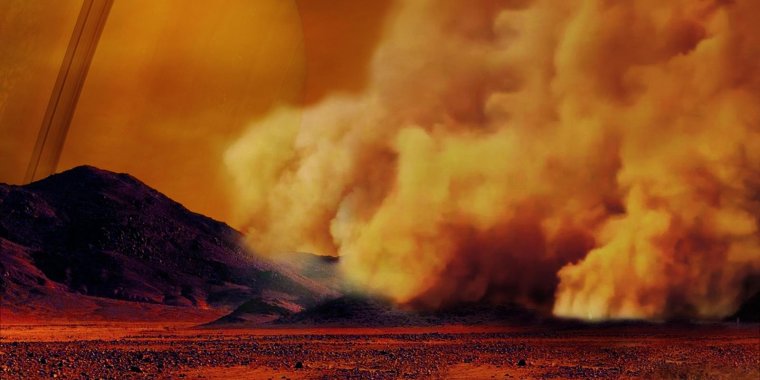| News / Science News |
Dust Storms on Titan Spotted for the First Time
Data from NASA's Cassini spacecraft has revealed what appear to be giant dust storms in equatorial regions of Saturn's moon Titan. The discovery makes Titan the third Solar System body, in addition to Earth and Mars, where dust storms have been observed.

Artist's concept of a dust storm on Titan. Credit: IPGP/Labex UnivEarthS/University Paris Diderot - C. Epitalon & S. Rodriguez
Titan is a very active moon. We already know that about its geology and exotic hydrocarbon cycle. Now we can add another analogy with Earth and Mars: the active dust cycle, in which organic dust can be raised from large dune fields around Titan's equator.
Titan is the only moon in the Solar System with a substantial atmosphere and the only celestial body other than our planet where stable bodies of surface liquid are known to still exist.
There is one big difference, though: On Earth such rivers, lakes and seas are filled with water, while on Titan it is primarily methane and ethane that flows through these liquid reservoirs. In this unique cycle, the hydrocarbon molecules evaporate, condense into clouds and rain back onto the ground.
The weather on Titan varies from season to season as well, just as it does on Earth. In particular, around the equinox -- the time when the Sun crosses Titan's equator -- massive clouds can form in tropical regions and cause powerful methane storms. Cassini observed such storms during several of its Titan flybys.
From what we know about cloud formation on Titan, we can say that such methane clouds in this area and in this time of the year are not physically possible. The convective methane clouds that can develop in this area and during this period of time would contain huge droplets and must be at a very high altitude -- much higher than the 6 miles (10 kilometers) that modeling tells us the new features are located.
The researchers were also able to rule out that the features were actually on the surface of Titan in the form of frozen methane rain or icy lavas. Such surface spots would have a different chemical signature and would remain visible for much longer than the bright features in this study, which were visible for only 11 hours to five weeks.
In addition, modeling showed that the features must be atmospheric but still close to the surface -- most likely forming a very thin layer of tiny solid organic particles. Since they were located right over the dune fields around Titan's equator, the only remaining explanation was that the spots were actually clouds of dust raised from the dunes.
Organic dust is formed when organic molecules, formed from the interaction of sunlight with methane, grow large enough to fall to the surface.
The near-surface wind speeds required to raise such an amount of dust as we see in these dust storms would have to be very strong -- about five times as strong as the average wind speeds estimated.
The existence of such strong winds generating massive dust storms implies that the underlying sand can be set in motion, too, and that the giant dunes covering Titan's equatorial regions are still active and continually changing.
The winds could be transporting the dust raised from the dunes across large distances, contributing to the global cycle of organic dust on Titan and causing similar effects to those that can be observed on Earth and Mars. (NASA)
YOU MAY ALSO LIKE


